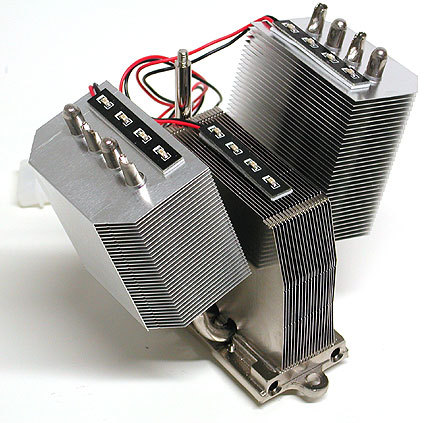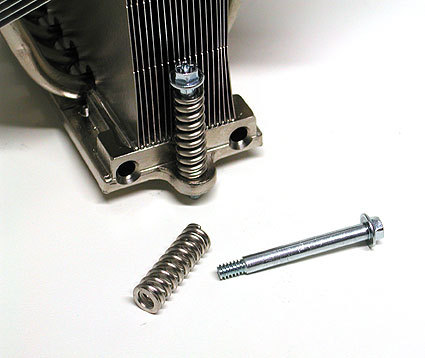Six New AMD Coolers: Cold Enough For You?
EKL V8
Elektronik Kuehlsystem Leutkirch GmBH (EKL AG) is an ISO9001 thermal solutions company based in Leutkirch, Germany, which has offered heatsinks to the European market since the mid 1990s. The innovative design of the EKL V8, and EKL's recent outreach to the enthusiast market for quiet cooling components, explain why we have included this item in our English review, even though the unit is not available for sale in the US. It can be mail-ordered from Germany, however.
This cooler doesn't include eight cylinders, but rather eight heatpipes, which give the EKL V8 its name. This vendor has years of experience in the OEM heatsink market, but the V8 represents its first retail offering. The design is indeed reminiscent of the layout of a V8 engine, and its esthetics are intended to appeal to casemodders. In that same vein, the cooler's twelve SMD LEDs - which use a separate Molex connector for power - permit the cooler to emit a bright blue glow.
Installation
Installing this cooler on a Socket 939 motherboard doesn't appear that difficult, at least not at first. Only two screws are needed to affix the cooler to the motherboard socket.
Quick in theory: AMD users only need to fasten two screws.
Watchmaker's heaven, hobbyist's hell: fasteners, backplates, and other items for use with Sockets 478 and 775.
But there is a catch to this simple-seeming task: it is an enormous pain to fasten the screws to the backplate. Even in a motherboard that has not yet been installed, it takes several minutes to find the right position for the screwdriver so that the screws don't start in at an incorrect angle, or the cooler slips out of alignment. Those who persist in their efforts - and do not throw the cooler out the window from sheer frustration - will find that the unit is unshakably affixed to the motherboard. After that, you must screw an additional bolt into the cooler to attach a plastic cover to the unit.
Get Tom's Hardware's best news and in-depth reviews, straight to your inbox.
A look under the V8's hood: how the cooler looks when mounted.
Connecting power to the cooler involves two hook-ups: the fan uses a connector to attach to a standard motherboard fan header block, or to an add-in fan controller. An additional lead provides power for the unit's blue LEDs. It's clear why these lights need their own power source: it takes 1.8 W to make them shine (the fan itself consumes less power!)
For die-hard casemodders: blue lights fascinate viewers
-
theali AMD box cooler is ~450g (I have one at my home). The data is not showing apples-to-apples comparison. AMD cooler is lighter than Zamlan Cooler by ~100 grams.Reply



